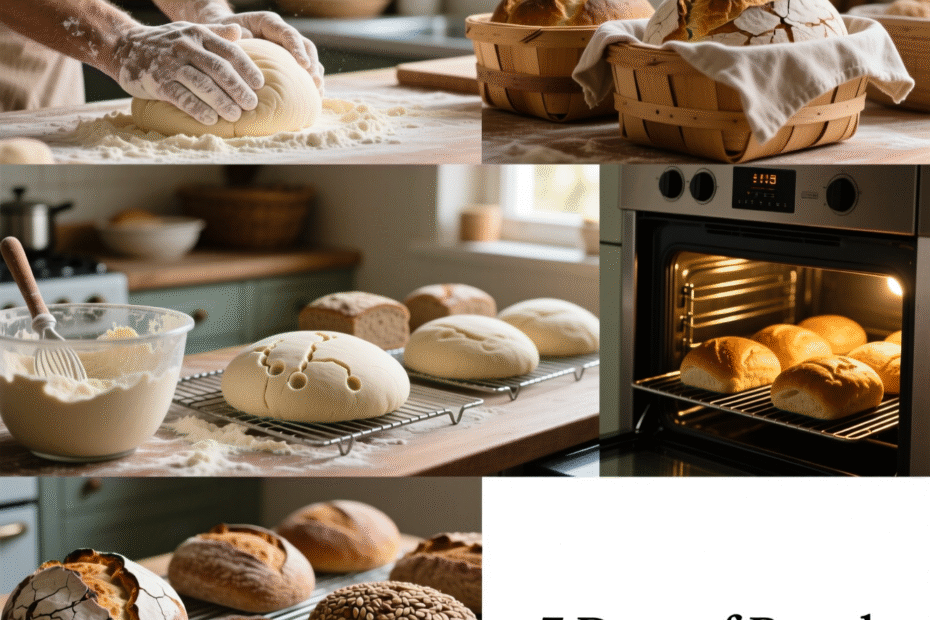Imagine waking up every morning to the warm, comforting aroma of freshly baked bread—without having to turn on the oven each day. Sounds like a dream? It’s not only possible—it’s surprisingly simple once you know how. Baking a week’s worth of bread in just one day is more than a time-saving hack; it’s a return to intentionality, self-reliance, and the deep satisfaction of creating something nourishing with your own hands.
In today’s fast-paced world, many of us rely on store-bought loaves that are often packed with preservatives and lack the soul of homemade bread. But what if you could reclaim that joy—and do it efficiently? This article will walk you through everything you need to know to plan, prepare, and bake multiple loaves in a single day, from choosing the right recipes and managing your time wisely to storing your bread so it stays fresh all week.
Whether you’re a seasoned baker or a curious beginner, this guide offers practical tips, real-life strategies, and inspiration to help you fill your kitchen (and your pantry) with wholesome, delicious bread—all in one satisfying baking session.
Why Bake a Week’s Worth of Bread at Once?
Baking bread in bulk might sound ambitious, but it’s rooted in both practicality and tradition. Before supermarkets and preservatives, families baked large batches of bread weekly—sometimes even monthly—because it was the most efficient way to feed a household. Today, that same principle holds true, especially for busy individuals and families who value real food but struggle to find time during the week.
One of the biggest advantages of baking in bulk is time efficiency. While making one loaf might take 3–4 hours from start to finish (including rising and baking), making four or five loaves often adds only 30–60 minutes to your total time. Why? Because much of bread-making is passive—dough rises while you clean, prep other loaves, or relax with a cup of tea. By batching your efforts, you maximize your active time and minimize repeated setup and cleanup.
Moreover, homemade bread simply tastes better and is healthier than most store-bought alternatives. You control the ingredients—no hidden sugars, emulsifiers, or dough conditioners. Plus, there’s a therapeutic rhythm to kneading, shaping, and watching dough transform in the oven. Baking a week’s worth in one go isn’t just about logistics; it’s an act of care—for your body, your home, and your peace of mind.
Planning Your Bread-Baking Day: Recipes, Timing, and Tools
Success starts long before the flour hits the counter. A well-planned baking day hinges on three things: recipe selection, timing, and equipment.
First, choose 2–3 complementary bread recipes that share similar techniques or rising times. For example, you might bake a basic sourdough, a whole wheat loaf, and a batch of dinner rolls. Avoid mixing recipes with wildly different hydration levels or fermentation needs unless you’re experienced. Simpler is better for your first bulk bake.
Next, map out your timeline. Start early—ideally by 7 or 8 a.m.—so you have the full day ahead. Here’s a sample schedule:
- 8:00 a.m.: Mix and knead first doughs (e.g., sourdough and whole wheat).
- 9:30 a.m.: Shape first loaves; let them proof while you prep the next batch.
- 11:00 a.m.: Bake first round; start mixing rolls or a no-knead loaf.
- 1:00 p.m.: Second bake; clean as you go.
- 3:00 p.m.: Final shaping and baking.
- 5:00 p.m.: Cool, slice, and store.
Having the right tools makes the process smoother: a large mixing bowl, bench scraper, kitchen scale, loaf pans, baking stone or steel, and plenty of cooling racks. Don’t forget parchment paper and clean kitchen towels for covering dough.
Pro tip: Label each dough with a sticky note indicating its type and expected bake time. It’s easy to lose track when juggling multiple batches!
Mastering the Art of Batch Baking Without Burnout
Baking all day sounds romantic—until you’re elbow-deep in flour at 4 p.m., wondering why you thought this was a good idea. The key to avoiding burnout is pacing and simplicity.
Start with no-knead or overnight-rise recipes whenever possible. These require minimal hands-on time and can be mixed the night before. For example, a no-knead whole grain loaf can ferment in the fridge overnight, then be shaped and baked the next morning with almost no morning prep.
Also, embrace multitasking wisely. While one batch proofs, clean your bowls, preheat the oven, or prep fillings for stuffed breads (like garlic-herb or cinnamon swirl). But don’t over-schedule—leave room for rest. Bread-making is as much about patience as it is about action.
Another strategy: bake similar breads back-to-back. If you’re making three loaves of sourdough, bake them in succession so your oven stays at the right temperature, and you’re not constantly adjusting settings. This also minimizes heat-up and cool-down cycles, saving energy.
Most importantly, keep your recipes approachable. Fancy braided challah or intricate laminated doughs are beautiful—but save them for weekends when you have more bandwidth. On your bulk baking day, prioritize reliability over showmanship. A humble, well-baked country loaf feeds the soul just as deeply.
Storing and Preserving Freshness All Week Long
Freshly baked bread is at its peak within hours of leaving the oven—but with smart storage, it can stay delicious for days. The biggest enemy of bread? Moisture loss and staling. Contrary to popular belief, the refrigerator accelerates staling, so avoid it unless you’re freezing.
For short-term storage (2–3 days), keep crusty loaves like sourdough in a paper bag on the counter. This preserves the crust while slowing moisture loss. For softer breads (like sandwich loaves or brioche), use a bread box or wrap them in a clean cotton towel inside a reusable plastic or beeswax wrap.
For longer storage, freeze your extra loaves. Slice them first for convenience—then pop individual slices into the toaster straight from the freezer. To freeze: cool completely, wrap tightly in foil or freezer-safe bags, and label with the date. Most breads freeze beautifully for up to 3 months.
Reviving stale bread is easier than you think. Sprinkle a loaf lightly with water and reheat in a 350°F (175°C) oven for 5–10 minutes. The crust crisps up, and the crumb softens—almost like new.
By planning your storage strategy in advance, you ensure that every slice throughout the week tastes as intentional as the first.
Beyond the Loaf: Building a Sustainable Bread Routine
Baking a week’s worth of bread isn’t just a one-off project—it can be the foundation of a more mindful, sustainable kitchen. Once you’ve done it once, you’ll likely want to repeat it. And that’s where the real magic happens: routine becomes ritual.
Consider maintaining a sourdough starter—it’s low-waste, endlessly versatile, and improves with time. Even if you don’t bake daily, feeding your starter once a week keeps it alive and ready for your next baking day. Plus, sourdough bread has natural preservatives (lactic acid) that help it stay fresh longer.
You can also customize loaves for different meals:
- A hearty rye for open-faced sandwiches
- Soft whole wheat for toast and school lunches
- Olive or herb focaccia for dinner sides
- Sweet cinnamon swirl for weekend treats
This variety ensures you never get bored—and reduces reliance on processed snacks or convenience foods.
Over time, you’ll notice other benefits: less food waste (no more half-eaten store loaves going moldy), lower grocery bills, and a deeper connection to what you eat. In a world of instant everything, baking your own bread is a quiet rebellion—a way to slow down, create, and nourish yourself on your own terms.
Conclusion
Baking a week’s worth of bread in one day might seem like a lofty goal, but with the right plan, it’s not only achievable—it’s deeply rewarding. From saving time and money to enjoying healthier, tastier bread every day, the benefits ripple far beyond your kitchen. You’ve learned how to choose efficient recipes, manage your time wisely, avoid burnout, store bread properly, and even build a sustainable baking habit that fits your lifestyle.
More than a practical skill, this practice is an invitation—to slow down, to create with your hands, and to reclaim a piece of daily life that’s often outsourced. There’s something profoundly grounding about shaping dough, watching it rise, and pulling golden loaves from the oven. It’s nourishment in every sense of the word.
So why not give it a try? Pick a quiet Saturday, gather your ingredients, and see what happens. You might just discover that the rhythm of bread-making brings a kind of calm you didn’t know you were missing.
We’d love to hear from you! Have you ever baked multiple loaves in one day? What’s your favorite bread to make in bulk? Share your tips, questions, or photos in the comments below—let’s build a community of home bakers, one loaf at a time.

Thayná Alves is an influential digital content creator who has carved out a significant space in the realms of technology, finance, and entrepreneurship. Through her blog, Newbacker.com , she stands out as an authentic and accessible voice for individuals seeking practical information about investments, innovation, and emerging trends in the financial market.
